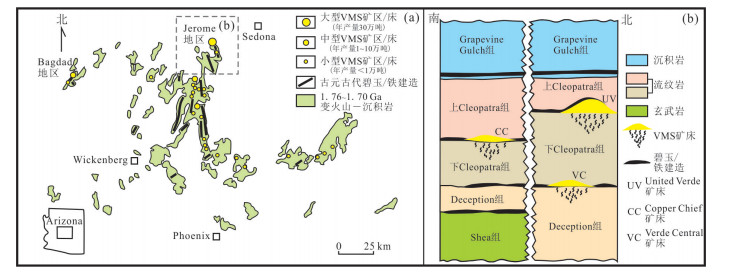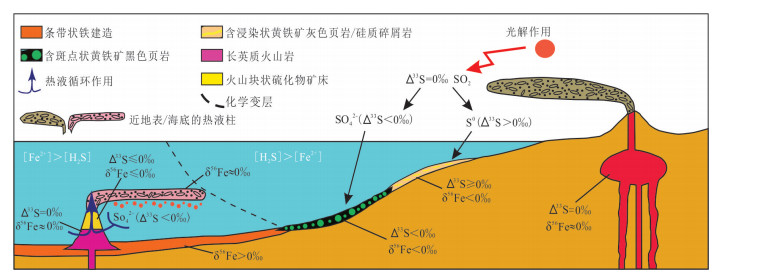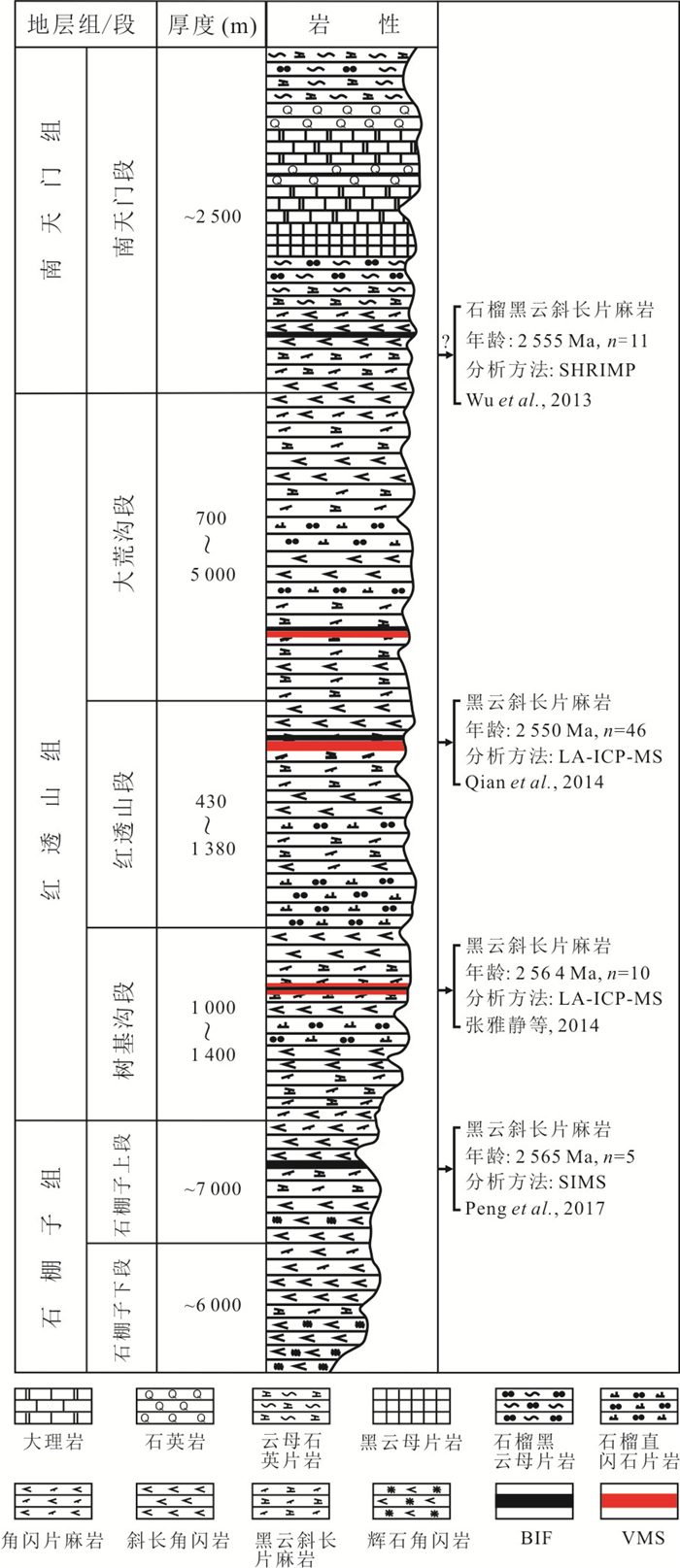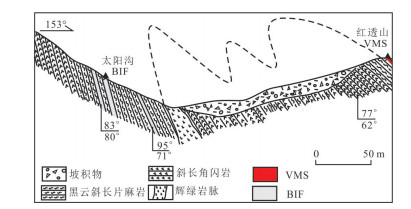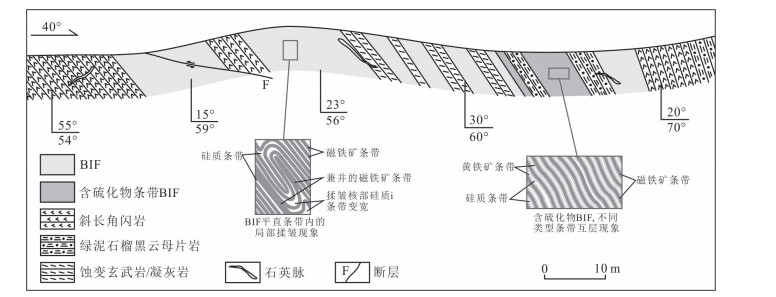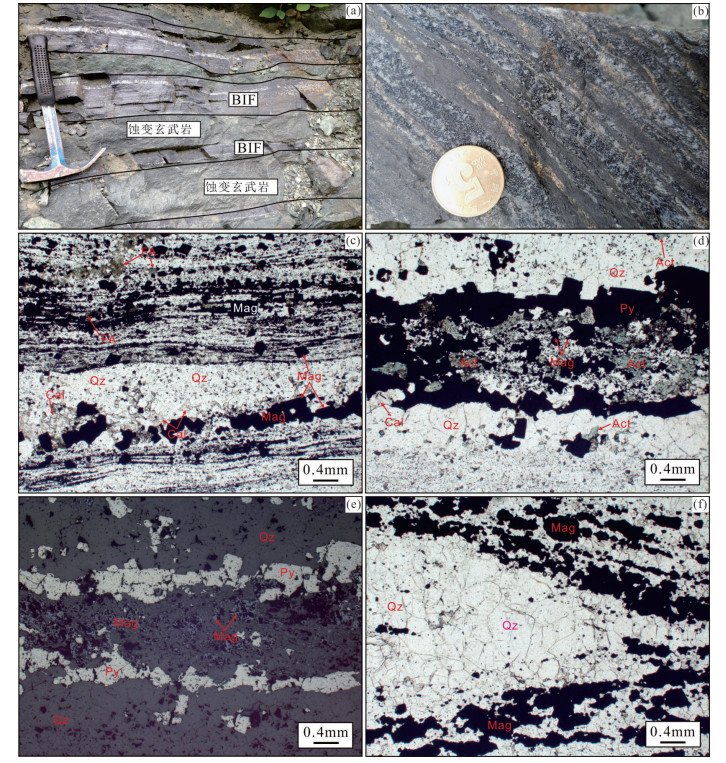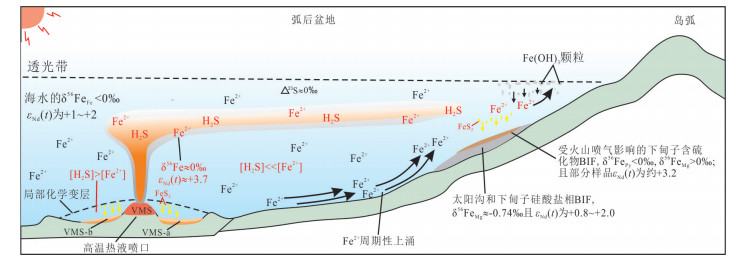Tectonic Setting and Genetic Relationship between BIF and VMS-in the Qingyuan Neoarchean Greenstone Belt, Northern North China Craton
-
摘要: 华北克拉通北缘新太古代清原绿岩带,以产出中国最古老的红透山火山岩型块状硫化物(VMS)铜锌矿床而闻名.但近年同位素年代学研究表明,该绿岩带还发育同期的条带状(BIF)铁矿.对该绿岩带开展BIF铁矿、VMS铜锌矿时空和成因关系及其形成构造背景和海洋环境的研究非常必要.在综述近年笔者及前人获得的清原绿岩带地质剖面观察、典型VMS铜锌矿床和BIF铁矿床地质、锆石U-Pb年代学、主微量元素和Nd-Fe-S同位素地球化学等资料的基础上,总结了清原绿岩带VMS-BIF矿床组合形成的构造背景、成矿物质来源及形成规律.最后建立了新太古代清原绿岩带VMS-BIF弧后盆地系统成矿模式.这对于指导区域找矿预测、了解新太古代陆壳演化和古海洋环境均有重要的科学意义.Abstract: The Neoarchean Qingyuan greenstone belt (QGB) is located in the northern margin of the North China Craton (NCC). It is characterized by the occurrence of the oldest Cu-Zn volcanogenic massive sulfide (VMS) deposits in China. Recent geochronological data indicates that the QGB also hosts a certain amount of Neoarchean BIF-type iron deposits. Hence,a detailed study on the enigmatic association of VMS and BIF deposits should be conducted urgently. In this study,the previous geological,U-Pb geochronological,element geochemical,as well as Nd-S-Fe isotopic data on the VMS,BIF,and associated lithologies of the QGB was reviewed in detail. Based on the review,we concluded the tectonic setting,source of ore-forming materials,and genesis of the QGB VMS-BIF paragenetic assemblage,and thus established a ore-forming model in a back-arc basin for the QGB VMS-BIF metallogenic system. Generally,this model is significant in assessing regionally metallogenic endowment,and also in better understanding Archean continental crust evolution and marine environment.
-
图 1 前寒武纪VMS、BIF和地壳增生时间演化
Fig. 1. Histogram showing the abundance of VMS and BIF together with the intensity of crust growth in Precambrian
图 2 北美太古代阿比提毕绿岩带VMS与BIF空间分布
改自Thurston et al.(2008);a.阿比提毕绿岩带;b.绿岩带内代表性地层柱状图
Fig. 2. Geological map showing the spatial relationship of VMS and BIF in the North American Archean Abitibi greenstone belt
图 3 美国亚利桑那州中元古代早期VMS与BIF共生分布
改自Slack et al.(2007);a.美国Arizona州中部地区地质简图,仅显示中元古代地层;b.Jerome地区南部和北部中元古代地层剖面图,为清楚展示VMS与BIF的相对空间位置,矿床规模进行了一定程度的扩大
Fig. 3. Geological map showing the distribution of VMS-BIF paragenetic assemblage in Arizona, USA
图 4 太古代VMS和BIF共生假想成因模式
改自Bekker et al.(2010)、Farquhar et al.(2011)
Fig. 4. Hypothetical genetic model schematic of Archean VMS-BIF paragenetic assemblage
图 5 新太古代清源绿岩带VMS铜锌矿与BIF铁矿空间分布简图
Fig. 5. Geological map showing the distribution of VMS-BIF paragenetic assemblage in Neoarchean Qingyuan greenstone belt, NCC
图 6 清原绿岩带表壳岩系综合柱状图
据彭自栋等(2018),图中给出了各组变酸性火山岩的形成年龄
Fig. 6. Stratigraphic column showing formation and member names for different rock assemblages in the QGB
图 8 下甸子BIF铁矿区代表性地质剖面
Fig. 8. Representative sketch profiles from the Xiadianzi BIF, showing relationships between the BIF and associated lithologies
图 9 下甸BIF与黄铁矿条带的野外和镜下照片
据彭自栋等(2017);a.互层的BIF和蚀变玄武岩,二者之间为整合接触,界线平直;b.由互层的富铁条带、富硅条带和黄铁矿条带构成的含硫化物BIF,三类条带间均为平直接触;c.硅酸盐相BIF的富铁条带由更细的磁铁矿和石英微条带构成,一些粗粒的(0.1~0.2 mm)磁铁矿和铁阳起石通常穿切这些微条带,同时在富硅条带中可见到少量的方解石颗粒(单偏光);d.含硫化物BIF的富铁条带中可见大量板条状阳起石(粒径0.2~0.4 mm)与石英颗粒交互生长,在富硅条带中可见到粉尘状磁铁矿、磁铁矿集合体及少量的方解石颗粒(单偏光);e.半自形-自形黄铁矿颗粒(0.1~0.5 mm)或构成连续的微条带或呈孤立的颗粒沿富铁条带边部分布(反射光);f.由纯净的磁铁矿微条带和石英微条带构成的氧化物相BIF,在磁铁矿微条带内可见到粗粒石英颗粒构成的结核(单偏光).矿物缩写:Mag.磁铁矿;Qz.石英;Act.阳起石;Py.黄铁矿
Fig. 9. Field photo and photomicrographs showing typical textures and petrographic relationships among main mineral phases in the Taiyanggou BIFs
图 10 清原绿岩带变英安岩样品地球化学图解
图a和图b分别为Zr/Y vs. Y和La/YbCN vs. YbCN酸性火山岩类型判别图解,改自Hart et al.(2004);图c和图d分别为Nb vs. Y和Ta vs. Yb酸性火山岩构造环境图解,改自Pearce et al.(1984)
Fig. 10. Geochemical diagrams of meta-dacite samples in the QGB
图 11 华北克拉通新太古代清原绿岩带BIF-VMS弧后盆地系统成矿模式
修改自彭自栋(2018);VMS.红透山VMS块状矿石,δ56FePy约为0‰;VMS-a.红透山VMS纹层状矿石,δ56FePy约为-0.55‰;VMS-b.红透山VMS纹层状矿石,δ56FePy约为+0.30‰
Fig. 11. Tectonic-sedimentary ore-forming model of VMS-BIF paragenetic assemblage in Neoarchean Qingyuan greenstone belt, NCC
-
Barley, M., Bekker, A., Krapez, B., 2005. Late Archean to Early Paleoproterozoic Global Tectonics, Environmental Change and the Rise of Atmospheric Oxygen. Earth and Planetary Science Letters, 238(1-2): 156-171. https://doi.org/10.1016/j.epsl.2005.06.062 Bekker, A., Slack, J. F., Planavsky, N., et al., 2010. Iron Formation: The Sedimentary Product of a Complex Interplay among Mantle, Tectonic, Oceanic, and Biospheric Processes. Economic Geology, 105(3): 467-508. https://doi.org/10.2113/gsecongeo.105.3.467 Dreher, A. M., Xavier, R. P., Taylor, B. E., et al., 2008. New Geologic, Fluid Inclusion and Stable Isotope Studies on the Controversial Igarapé Bahia Cu-Au Deposit, Carajás Province, Brazil. Mineralium Deposita, 43(2): 161-184. https://doi.org/10.1007/s00126-007-0150-6 Farquhar, J., Zerkle, A. L., Bekker, A., 2011. Geological Constraints on the Origin of Oxygenic Photosynthesis. Photosynthesis Research, 107(1): 11-36. https://doi.org/10.1007/s11120-010-9594-0 Franklin, J. M., Gibson, H. L., Jonasson, I. R., et al., 2005. Volcanogenic Massive Sulfide Deposits. Economic Geology 100th Anniversary Volume. SEG, Littleton, 523-560. German, C. R., Von Damm, K. L., 2004, Hydrothermal Processes: Treatise on Geochemistry. Pergamon, Oxford, 181-222. Gu, L. X., Zheng, Y. C., Tang, X. Q., et al., 2007. Copper, Gold and Silver Enrichment in Ore Mylonites within Massive Sulphide Orebodies at Hongtoushan VHMS Deposit, N.E. China. Ore Geology Reviews, 30(1): 1-29. https://doi.org/10.1016/j.oregeorev.2005.09.001 Hart, T. R., Gibson, H. L., Lesher, C. M., 2004. Trace Element Geochemistry and Petrogenesis of Felsic Volcanic Rocks Associated with Volcanogenic Massive Cu-Zn-Pb Sulfide Deposits. Economic Geology, 99(5): 1003-1013. https://doi.org/10.2113/gsecongeo.99.5.1003 Hou, K. J., Li, Y. H., Wan, D. F., 2006. Stable Isotope Geochemistry and Genesis of the Archean Hongtoushan Sulfide Deposit in Liaoning Province. Mineral Deposits, 25(Suppl.): 167-170 (in Chinese with English abstract). Huston, D. L., Champion, D. C., Cassidy, K. F., 2014. Tectonic Controls on the Endowment of Neoarchean Cratons in Volcanic-Hosted Massive Sulfide Deposits: Evidence from Lead and Neodymium Isotopes. Economic Geology, 109(1): 11-26. https://doi.org/10.2113/econgeo.109.1.11 Huston, D. L., Logan, G. A., 2004. Barite, BIFs and Bugs: Evidence for the Evolution of the Earth's Early Hydrosphere. Earth and Planetary Science Letters, 220(1-2): 41-55. https://doi.org/10.1016/s0012-821x(04)00034-2 Huston, D. L., Pehrsson, S., Eglington, B. M., et al., 2010. The Geology and Metallogeny of Volcanic-Hosted Massive Sulfide Deposits: Variations through Geologic Time and with Tectonic Setting. Economic Geology, 105(3): 571-591. https://doi.org/10.2113/gsecongeo.105.3.571 Isley, A. E., 1995. Hydrothermal Plumes and the Delivery of Iron to Banded Iron Formation. The Journal of Geology, 103(2): 169-185. https://doi.org/10.1086/629734 Isley, A. E., Abbott, D. H., 1999. Plume-Related Mafic Volcanism and the Deposition of Banded Iron Formation. Journal of Geophysical Research: Solid Earth, 104(B7): 15461-15477. https://doi.org/10.1029/1999jb900066 Li, B. L., Huo, L., Li, Y. S., 2007. Several Problems Involved in the Study of Banded Iron Formations(BIFs). Acta Mineralogica Sinica, 27(2): 205-210 (in Chinese with English abstract). http://www.wanfangdata.com.cn/details/detail.do?_type=perio&id=kwxb200702016 Li, Y. H., Hou, K. J., Wan, D. F., et al., 2010. Formation Mechanism of Precambrian Banded Iron Formation and Atmosphere and Ocean during Early Stage of the Earth. Acta Geologica Sinica, 84(9): 1359-1373 (in Chinese with English abstract). http://www.wanfangdata.com.cn/details/detail.do?_type=perio&id=dizhixb201009010 Li, Z., Wei, C. J., 2017. Two Types of Neoarchean Basalts from Qingyuan Greenstone Belt, North China Craton: Petrogenesis and Tectonic Implications. Precambrian Research, 292: 175-193. https://doi.org/10.1016/j.precamres.2017.01.014 Li, Z. H., Zhu, X. K., Tang, S. H., 2012. Mineralization Mechanism of Precambrian Banded Iron Formation and Atmosphere and Ocean Environment in Early Earth—Evidences from Iron Isotope and Element Geochemistry. Acta Petrologica Sinica, 28(11): 3545-3558 (in Chinese with English abstract). Malinowski, M., White, D.J., Mwenifumbo, C. J., et al., 2008. Seismic Exploration for VMS Deposits within the Paleoproterozoic Flin Flon Belt, Trans-Hudson Orogen, Canada. Geophysical Research, 10: 37-45. Mao, D. B., Shen, B. F., Li, J. J., et al., 1997. Archena Geologica and Metallogeny in Qingyuan Area, Northern Liaoning Province, China. Progress in Precambrian Research, 20(3):1-10 (in Chinese with English abstract). Ohmoto, H., Watanabe, Y., Yamaguchi, K.E., et al., 2006. Chemical and Biological Evolution of Early Earth: Constraints from Banded Iron Formations. Geological Society of America Memoir, 198:291-331. https://doi.org/10.1130/2006.1198(17 Pearce, J. A., Harris, N. B. W., Tindle, A. G., 1984. Trace Element Discrimination Diagrams for the Tectonic Interpretation of Granitic Rocks. Journal of Petrology, 25(4): 956-983. https://doi.org/10.1093/petrology/25.4.956 Peng, P., Wang, C., Wang, X. P., et al., 2015. Qingyuan High-Grade Granite-Greenstone Terrain in the Eastern North China Craton: Root of a Neoarchaean Arc. Tectonophysics, 662: 7-21. https://doi.org/10.1016/j.tecto.2015.04.013 Peng, Z. D., 2018. Geodynamic Setting and Depositional Environment of the VMS-BIF Paragenetic Assemblage in the Neoarchean Qingyuan Greenstone Belt, North China Craton(Dissertation). Institute of Geology and Geophysics, Chinese Academy of Sciences, Beijing (in Chinese with English abstract). Peng, Z. D., Wang, C. L., Tong, X. X., et al., 2018. Element Geochemistry and Neodymium Isotope Systematics of the Neoarchean Banded Iron Formations in the Qingyuan Greenstone Belt, North China Craton. Ore Geology Reviews, 102: 562-584. https://doi.org/10.1016/j.oregeorev.2018.09.008 Peng, Z. D., Wang, C. L., Zhang, L. C., et al., 2017. Geochemistry of Metamorphosed Volcanic Rocks in the Neoarchean Qingyuan Greenstone Belt, North China Craton: Implications for Geodynamic Evolution and VMS Mineralization. Precambrian Research, 326: 196-221. https://doi.org/10.1016/j.precamres.2017.12.033 Peng, Z. D., Wang, C. L., Zhao, G., et al., 2017. Research Progress and Problems of Precambrian VMS-BIF Paragenetic Assemblage. Mineral Deposits, 36(4): 905-920 (in Chinese with English abstract). http://www.wanfangdata.com.cn/details/detail.do?_type=perio&id=kcdz201704008 Peng, Z. D., Zhang, L. C., Wang, C. L., et al., 2018. Geological Features and Genesis of the Neoarchean Pyrite-Bearing Xiadianzi BIF, Qingyuan Greenstone Belt. Acta Petrologica Sinica, 34(2):398-426 (in Chinese with English abstract). http://d.old.wanfangdata.com.cn/Periodical/ysxb98201802016 Piercey, S. J., 2010. An Overview of Petrochemistry in the Regional Exploration for Volcanogenic Massive Sulphide(VMS)Deposits. Geochemistry: Exploration, Environment, Analysis, 10(2): 119-136. https://doi.org/10.1144/1467-7873/09-221 Qi, S. J., Wang, C. Y., Yang, J. P., et al., 1983. The Origin of the Precambrian Metavolcanic-Sedimentary Rock Systems and the Massive Sulfide Deposits in Xingshutai Neiqiu, Hebei Province. Journal of Hebei College of Geology, 22(2): 1-16 (in Chinese). Qian, Y., Sun, F. Y., Zhang, Y.J., et al., 2014. Metallogenic and Metamorphic Age of the Hongtoushan Copper-Zinc Massive Sulfide Deposit, Liaoning Province, China. Resource Geology, 64(1): 17-24. https://doi.org/10.1111/rge.12023 Rasmussen, B., Fletcher, I. R., Bekker, A., et al., 2012. Deposition of 1.88-Billion-Year-Old Iron Formations as a Consequence of Rapid Crustal Growth. Nature, 484(7395): 498-501. https://doi.org/10.1038/nature11021 Schardt, C., Large, R., Yang, J.W., 2006. Controls on Heat Flow, Fluid Migration, and Massive Sulfide Formation of an Off-Axis Hydrothermal System—The Lau Basin Perspective. American Journal of Science, 306(2): 103-134. https://doi.org/10.2475/ajs.306.2.103 Schneider, D. A., Bickford, M. E., Cannon, W. F., et al., 2002. Age of Volcanic Rocks and Syndepositional Iron Formations, Marquette Range Supergroup: Implications for the Tectonic Setting of Paleoproterozoic Iron Formations of the Lake Superior Region. Canadian Journal of Earth Sciences, 39(6): 999-1012. https://doi.org/10.1139/e02-016 Slack, J. F., Cannon, W. F., 2009. Extraterrestrial Demise of Banded Iron Formations 1.85 Billion Years ago. Geology, 37(11): 1011-1014. https://doi.org/10.1130/g30259a.1 Slack, J. F., Grenne, T., Bekker, A., 2009. Seafloor-Hydrothermal Si-Fe-Mn Exhalites in the Pecos Greenstone Belt, New Mexico, and the Redox State of ca. 1 720 Ma Deep Seawater. Geosphere, 5(3): 302-314. https://doi.org/10.1130/ges00220.1 Slack, J. F., Grenne, T., Bekker, A., et al., 2007. Suboxic Deep Seawater in the Late Paleoproterozoic: Evidence from Hematitic Chert and Iron Formation Related to Seafloor-Hydrothermal Sulfide Deposits, Central Arizona, USA. Earth and Planetary Science Letters, 255(1-2): 243-256. https://doi.org/10.1016/j.epsl.2006.12.018 Thurston, P. C., Ayer, J. A., Goutier, J., et al., 2008. Depositional Gaps in Abitibi Greenstone Belt Stratigraphy: A Key to Exploration for Syngenetic Mineralization. Economic Geology, 103(6): 1097-1134. https://doi.org/10.2113/gsecongeo.103.6.1097 Thurston, P. C., Kamber, B. S., Whitehouse, M., 2012. Archean Cherts in Banded Iron Formation: Insight into Neoarchean Ocean Chemistry and Depositional Processes. Precambrian Research, 214-215: 227-257. https://doi.org/10.1016/j.precamres.2012.04.004 Veizer, J., Laznicka, P., Jansen, S. L., 1989. Mineralization through Geologic Time; Recycling Perspective. American Journal of Science, 289(4): 484-524. https://doi.org/10.2475/ajs.289.4.484 Wan, Y. S., Song, B., Yang, C., et al., 2005. Zircon SHRIMP U-Pb Geochronology of Archaean Rocks from the Fushun-Qingyuan Area, Liaoning Province and Its Geological Significance. Acta Geologica Sinica, 79(1): 78-87 (in Chinese with English abstract). http://www.wanfangdata.com.cn/details/detail.do?_type=perio&id=dizhixb200501009 Wang, C. L., Zhang, L. C., Liu, L., et al., 2012. Research Progress and Some Problems Deserving Further Discussion of Precambrian Iron Formations. Mineral Deposits, 31(6): 1311-1325 (in Chinese with English abstract). http://www.wanfangdata.com.cn/details/detail.do?_type=perio&id=kcdz201206015 Wu, K. K., Zhao, G. C., Sun, M., et al., 2013. Metamorphism of the Northern Liaoning Complex: Implications for the Tectonic Evolution of Neoarchean Basement of the Eastern Block, North China Craton. Geoscience Frontiers, 4(3): 305-320. https://doi.org/10.1016/j.gsf.2012.11.005 Wyman, D. A., Kerrich, R., Polat, A., 2002. Assembly of Archean Cratonic Mantle Lithosphere and Crust: Plume-Arc Interaction in the Abitibi-Wawa Subduction-Accretion Complex. Precambrian Research, 115(1-4): 37-62. https://doi.org/10.1016/s0301-9268(02)00005-0 Yang, X. Q., Zhang, Z. H., Duan, S. G., et al., 2016. Mineralogical and Sulfur Isotope Characteristics of Huashugou Copper Deposit in Northern Qilian: Implications for Metallogenesis. Mineral Deposit, 35(1): 185-195 (in Chinese with English abstract). Yu, F. J., 2006. The Study of Metallogenic Model and Prospecting Pattern of Hongtoushan-Type Deposit(Dissertation). Northeastern University, Shenyang (in Chinese with English abstract). Zhai, M. G., Yang, R. Y., Lu, W. J., et al., 1985. Geochemistry and Evolution of the Qingyuan Archaean Granite—Greenstone Terrain, NE China. Precambrian Research, 27(1-3): 37-62. https://doi.org/10.1016/0301-9268(85)90005-1 Zhang, L. C., Ji, J. S., Xue, C. J., et al., 1997. Geochemistry and Origin of Huashugou Fe-Cu Deposit in Gansu Province. Journal of Xi'an Geological College, 19(4):13-19 (in Chinese with English abstract). Zhang, L. C., Zhai, M. G., Wan, Y. S., et al., 2012. Study of the Precambrian BIF-Iron Deposits in the North China Craton: Progresses and Questions. Acta Petrologica Sinica, 28(11): 3431-3445 (in Chinese with English abstract). http://d.old.wanfangdata.com.cn/Periodical/ysxb98201211001 Zhang, L. C., Zhai, M. G., Zhang, X. J., et al., 2012. Formation Age and Tectonic Setting of the Shirengou Neoarchean Banded Iron Deposit in Eastern Hebei Province: Constraints from Geochemistry and SIMS Zircon U-Pb Dating. Precambrian Research, 222-223: 325-338. https://doi.org/10.1016/j.precamres.2011.09.007 Zhang, Q. S., Li, S. Y., Liu, L. D., 1984. Precambrian Geology and Mineralization, China. Jilin Peoples Publishing House, Changchun, 166-171 (in Chinese). Zhang, Y. J., Sun, F. Y., Huo, L., et al., 2014. Metallogenic Age and Ore Remobilization of Shujigou Coper-Zinc Deposit, Liaoning Province, China. Journal of Jilin University(Earth Science Edition), 44(3): 786-795 (in Chinese with English abstract). http://www.wanfangdata.com.cn/details/detail.do?_type=perio&id=cckjdxxb201403007 Zhu, M. T., Zhang, L. C., Dai, Y. P., et al., 2015. In Situ Zircon U-Pb Dating and O Isotopes of the Neoarchean Hongtoushan VMS Cu-Zn Deposit in the North China Craton: Implication for the Ore Genesis. Ore Geology Reviews, 67: 354-367. https://doi.org/10.1016/j.oregeorev.2014.12.019 侯可军, 李延河, 万德芳, 2006.辽宁太古代红透山铜矿的稳定同位素地球化学特征及矿床成因.矿床地质, 25(增刊): 167-170. http://d.old.wanfangdata.com.cn/Conference/6278275 李碧乐, 霍亮, 李永胜, 2007.条带状铁建造(BIFs)研究的几个问题.矿物学报, 27(2): 205-210. http://d.old.wanfangdata.com.cn/Periodical/kwxb200702016 李延河, 侯可军, 万德芳, 等, 2010.前寒武纪条带状硅铁建造的形成机制与地球早期的大气和海洋.地质学报, 84(9): 1359-1373 http://d.old.wanfangdata.com.cn/Periodical/dizhixb201009010 李志红, 朱祥坤, 唐索寒, 2012.鞍山-本溪地区条带状铁矿的成矿机理及地球早期的海洋环境——来自Fe同位素和元素地球化学的证据.岩石学报, 28(11): 3545-3558 毛德宝, 沈保丰, 李俊建, 等, 1997.辽北清原地区太古宙地质演化及其对成矿的控制作用.前寒武纪研究进展, 20(3): 1-10. 彭自栋, 2018.华北克拉通新太古代清原绿岩带VMS-BIF共生组合成矿构造背景及沉积环境(博士学位论文).北京: 中国科学院地质与地球物理研究所. 彭自栋, 王长乐, 赵刚, 等, 2017.前寒武纪VMS与BIF铁矿床共生组合研究进展.矿床地质. 36(4): 905-920. http://d.old.wanfangdata.com.cn/Periodical/kcdz201704008 彭自栋, 张连昌, 王长乐, 等, 2018.新太古代清原绿岩带下甸子BIF铁矿地质特征及含黄铁矿条带BIF的成因探讨.岩石学报. 34(2): 398-426. http://d.old.wanfangdata.com.cn/Periodical/ysxb98201802016 祁思敬, 王承义, 杨剑平, 等, 1983.河北内丘杏树台前寒武纪变质火山岩系及层状硫化物矿床成因.河北地质学院学报, 22(2): 1-16. 万渝生, 宋彪, 杨淳, 等, 2005.辽宁抚顺-清原地区太古宙岩石SHRIMP锆石U-Pb年代学及其地质意义.地质学报, 79(1): 78-87. http://d.old.wanfangdata.com.cn/Periodical/dizhixb200501009 王长乐, 张连昌, 刘利, 等, 2012.前寒武纪条带状铁建造研究进展和值得进一步讨论的问题.矿床地质, 31(6): 1311-1325. 杨秀清, 张作衡, 段士刚, 等, 2016.北祁连桦树沟铜矿床矿物学和硫同位素特征及其成矿意义.矿床地质, 35(1):185-195. http://d.old.wanfangdata.com.cn/Periodical/kcdz201601012 于凤金, 2006.红透山式矿床成矿模式与找矿模型研究(博士学位论文).沈阳: 东北大学. 张连昌, 姬金生, 薛春纪, 等, 1997.甘肃桦树沟铁铜矿床地球化学及成因.西安地质学院学报, 19(4): 13-19. 张连昌, 翟明国, 万渝生, 等, 2012.华北克拉通前寒武纪BIF铁矿研究:进展与问题.岩石学报, 28(11): 3431-3445. http://d.old.wanfangdata.com.cn/Conference/7895390 张秋生, 李守义, 刘连登, 1984.中国早前寒武纪地质及成矿作用.长春:吉林人民出版社, 166-171. 张雅静, 孙丰月, 霍亮, 等, 2014.辽宁树基沟铜锌矿成矿时代及矿石再活化机制.吉林大学学报(地球科学版), 44(3):786-795. http://d.old.wanfangdata.com.cn/Periodical/cckjdxxb201403007 -









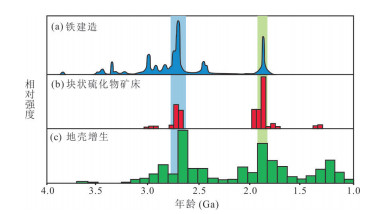
 下载:
下载:

